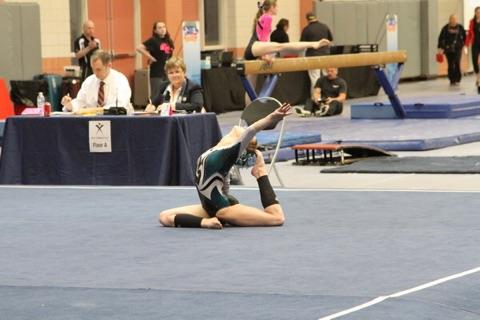Gymnastics is 18-year-old Anna Calloway’s favorite activity, but three years ago, the budding club team gymnast had to put her sport on hold.

Anna, of Knoxville, Tenn., was diagnosed with a stress fracture of her first left rib in June 2013. She stepped back from her year-round practicing for a couple of months; once she got back into her routine, she developed numbness and tingling in her left arm and hand, particularly when she held her arm out. These can be symptoms of neurogenic thoracic outlet syndrome (TOS), which results from repetitive shoulder motion and is caused by compression of the brachial plexus nerve roots within the scalene triangle.
“At the beginning of October, it was hurting more,” Anna says. “It started getting difficult again.”
Anna competes on bars, beam, floor and vault. Of the four, competing on bars requires the most of her shoulder – constant motion and hanging – so she had to stop her gymnast routine.
After several doctor’s visits and an Internet search by her mom, Kellie, Anna consulted vascular surgeon Robert Thompson, MD, director of the Washington University Center for Thoracic Outlet Syndrome at Barnes-Jewish Hospital. Thompson made a diagnosis of neurogenic TOS.
Dr. Thompson says Anna’s neurogenic TOS was not caused by the stress fracture, but the two sometimes occur together as a result of the same physical activity. He has treated other gymnasts for TOS, as well as a wide range of amateur, college and professional athletes who participate in baseball, basketball, ballet dancing and recreational sports.
Dr. Thompson performed Anna’s surgery on December 29, 2013. From an approach above the clavicle, he removed the first rib and the two scalene muscles that attach to it. He removed scar tissue that had formed around the brachial plexus nerves and mobilized each of the brachial plexus nerves. Through a small second incision below the collarbone, Dr. Thompson released the tendon of the pectoralis minor muscle and opened up the space all the way through the thoracic outlet for the brachial plexus nerves.
Anna saw a physical therapist in St. Louis a week after surgery and continued physical therapy in Knoxville for several months. She returned to gymnastics after about 4 months, but wasn’t allowed to practice on the bars. She was back into a full routine 6 months after the operation.
“It initially took a lot of physical therapy to even be able to move my arm,” says Anna. “In the first week or two, there was a lot of pain, but it improved quickly. Since then, I have gotten completely better and am fully back to gymnastics. I don’t have any problems with my shoulder at all.”
Anna’s recovery was so complete that by the fall after her surgery (eight months later) she joined the rock climbing team at her high school and competed in all four gymnastics events.
Now a senior in high school, Anna may compete on a club gymnastics team in college and would like to pursue a career in sports medicine, perhaps working as a physical therapist, coach or a combination of the two.
“I went through so much physical therapy that I really connected with my physical therapist. It made an impact on what I wanted to do later in my life,” Anna says.
This year, Anna qualified at the Tennessee state meet to compete at the Region 8 All-Stars meet. She placed fifth all around in her age group with a third place on bars, fifth on beam and fourth on floor.
Anna shows her arm and shoulder strength.